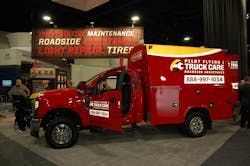Pilot Flying J aims to double maintenance locations by next year
ATLANTA. With 11 shops and a 150-truck fleet now established as part of its five-year plan to add both fixed and mobile maintenance services within its U.S. truck stop network, Pilot Flying J (PFJ) is now focused on doubling its number of shop locations by next year, with seven more maintenance "service centers" in planning stages right now to be opened by mid-year.
“Our goal is that whether you operate one truck or a fleet of 10,000, our shops can take care of your common maintenance needs,” explained David Latimer, PFJ’s vice president of shops strategy. “Now, we’re not doing engine rebuilds and heavy work like that. But we’re doing the most common planned and unplanned maintenance a truck operator encounters: oil changes, tire work, etc.”
In an interview with Fleet Owner at the Technology & Maintenance Council (TMC) 2018 annual meeting, Latimer – a longtime truck stop industry veteran who established the Petro Stopping Centers (now owned by TravelCenters of America) network of maintenance shops and who joined PFJ in July of 2016 – said the real key to the company’s maintenance strategy is taking care of that 70% of “common items” that lead to roadside safety violations: tires, wheel ends, and lights.
“Our whole focus is to help prevent out of service violations for those most common problems,” he explained. “A year ago, if you came onto one of our properties with one of those [maintenance] problems, we would have had to tell you to go somewhere else to get it fixed. Not anymore.”
Latimer’s personal goal is to keep expanding PFJ’s shop network and beef up its mobile maintenance truck fleet to between 200 and 250 units.
“We can’t be everything to everybody when it comes to maintenance,” he said. “But part of the idea is to be the ‘one bill’ for the customer, so they have one person to either complain to or compliment. It’s that goal of being the ‘one stop shop’ where a driver can come in for a scheduled PM and then get a shower, so a little shopping, and eat a meal while they wait – all in one place. That is where everyone wants to be.”
PFJ noted that it now operates a combined network of more than 750 Pilot and Flying J Travel Centers across North America, serving more than 1.2 million customers daily.
About the Author
Sean Kilcarr
Editor in Chief
Sean Kilcarr is a former longtime FleetOwner senior editor who wrote for the publication from 2000 to 2018. He served as editor-in-chief from 2017 to 2018.
